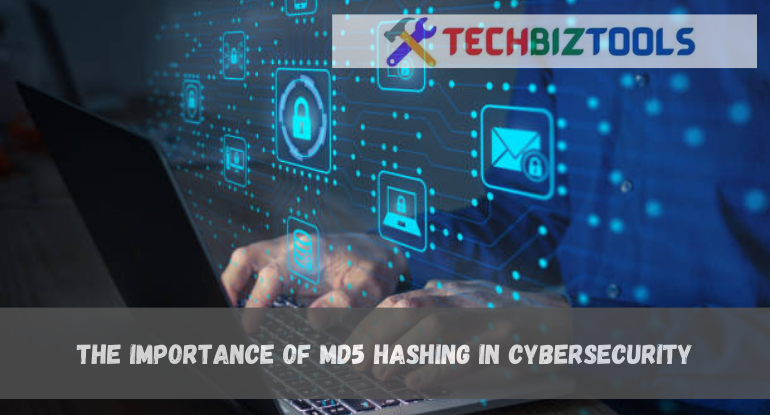
The Importance of MD5 Hashing in Cybersecurity
In cybersecurity, strong encryption and hashing are crucial for safeguarding sensitive data. Among various techniques, MD5 hashing is foundational but has strengths, weaknesses, and a notable history.
Initially praised for its efficiency, MD5 became widely used but later revealed vulnerabilities to attacks, prompting a shift to more secure alternatives.
Despite its flaws, MD5's impact on cybersecurity's evolution remains significant, teaching valuable lessons about adapting security measures in the face of evolving threats.
What is MD5 Hashing?

MD5, or Message Digest Algorithm 5, represents a cryptographic hashing technique crafted by Ronald Rivest back in 1991. Its purpose was straightforward: generate a 128-bit hash value, usually depicted as a 32-character hexadecimal sequence, from any amount of input data.
This function was revolutionary for its capability to take in data of varying lengths and create a consistent-sized output, known as the hash value or digest.
In essence, regardless of how much information you feed into MD5, it distills it down to a specific, fixed-size code that serves as a unique signature for that data.
The Process of MD5 Hashing
The MD5 hashing process encompasses several sequential steps that define its functionality:
#1. Input Acceptance: MD5, as a hashing algorithm, embraces all data types and sizes indiscriminately. It welcomes diverse information, spanning from short text strings to expansive files, without bias.
Its openness allows processing of varied formats like text, numbers, images, and more. This versatility makes MD5 widely used, though its vulnerabilities are noted in contemporary security.
Its unbiased acceptance of diverse data types remains a core attribute despite its limitations in modern cybersecurity.
#2. Hashing Operations: When the input data is fed into MD5, it undergoes a series of intricate logical operations. These operations involve intricate mathematical computations that transform the input data into a fixed-size hash value.
This transformation involves several rounds of processing, manipulating the input in a manner that produces a unique code, the hash value, of a predetermined length (usually 128 bits or 32 characters in hexadecimal form).
#3. Unique Output Generation: One of the key attributes of MD5 lies in its ability to generate a distinct hash output for every distinct input. Even the slightest alteration in the input data, be it a single character change or a minute adjustment, results in a vastly different hash output.
This property is essential as it ensures that each piece of input data, no matter how similar, is associated with a completely unique hash value.
This uniqueness principle, often termed the "Avalanche Effect," highlights MD5's strength in transforming data into hash values where even a minor modification in the input data causes a cascading alteration in the resulting hash output.
This characteristic solidifies the security and integrity checks, enabling users to easily detect any tampering or manipulation of the original data by comparing hash values.
MD5's systematic process, from input acceptance through intricate hashing operations to the generation of distinct hash outputs, forms the core foundation of its functionality in ensuring data integrity and security in the digital realm.
Importance in Cybersecurity

#1. Data Integrity Verification
MD5 hashing stands as a fundamental tool for ensuring the integrity and authenticity of digital information. By computing a unique hash value for a file or any data set, MD5 facilitates a mechanism to verify if the data has undergone any unauthorized modifications or tampering.
Even the slightest alteration, no matter how minuscule, in the original data will result in a markedly distinct hash value. This stark contrast in the generated hash serves as a clear indicator that the data has been compromised, enabling swift detection of any unauthorized changes.
#2. Password Storage (with Acknowledged Vulnerabilities)
Historically, MD5 was employed for storing passwords in databases. When users create or update their passwords, MD5 hash functions are utilized to transform and store the hashed value instead of the actual password itself.
This strategy was adopted as a security measure to shield the original passwords from exposure in case of a data breach. However, due to identified vulnerabilities, MD5 is now considered inadequate for modern security standards.
Its susceptibility to various attacks has rendered hashed passwords vulnerable to exploitation, prompting a shift to more secure hashing algorithms.
#3. Digital Signatures for Authentication
In specific systems, MD5 hashing finds application in generating digital signatures, particularly for verifying the authenticity and integrity of electronic documents or messages.
Through MD5, data is transformed into a hash value, and this resulting hash is encrypted using a private key. This process generates a digital signature that acts as a unique identifier, verifying both the legitimacy of the document or message and its unaltered state since the signature's creation.
However, due to identified vulnerabilities in MD5, stronger and more secure hash functions are recommended for generating digital signatures in contemporary security protocols.
#4. Checksums for Data Transmission
MD5 checksums are employed in data transmission to validate the integrity of transferred data. By computing an MD5 hash value at the source and comparing it to the computed value at the destination, any alterations or data corruption during transmission can be identified.
Although MD5's vulnerabilities are acknowledged, it is still utilized in certain non-critical applications where a lower level of security suffices.
Limitations and Vulnerabilities of MD5 Hashing
Detailed exploration of the limitations and vulnerabilities associated with MD5 hashing:
#1. Collision Vulnerabilities: MD5's vulnerabilities became glaringly apparent in the mid-2000s when collision vulnerabilities were identified. These vulnerabilities allowed attackers to manipulate different inputs in a way that resulted in the generation of the same MD5 hash output.
This fundamental flaw significantly compromised the reliability and security of MD5, opening the door to potential malicious exploitation.
Collision attacks essentially undermined the core principle of hashing, where each unique input should produce a distinct hash value, raising serious concerns about the reliability of MD5 for security-critical applications.
#2. Susceptibility to Malicious Exploitation: The presence of collision vulnerabilities in MD5 posed severe security risks, making it vulnerable to exploitation by malicious entities.
Cyber attackers could leverage these weaknesses to craft specially designed inputs that, despite being different in content, generated identical MD5 hash outputs.
This exploitation potential was a critical concern, especially in security-sensitive environments where data integrity and authenticity are paramount.
#3. Inadequacy for Security-Critical Applications: The discovery of collision vulnerabilities rendered MD5 inadequate and unsuitable for security-critical applications.
Its compromised security undermined its reliability in scenarios where robust data integrity and protection against malicious tampering are essential, such as digital signatures, cryptographic protocols, and password storage in high-security systems.
#4. Migration to More Secure Hashing Algorithms: The identified vulnerabilities in MD5 prompted a widespread shift within the cybersecurity community towards adopting more secure hashing algorithms.
Contemporary security standards emphasize the use of hashing functions like SHA-256 or SHA-3, which offer enhanced resistance against known vulnerabilities, including collision attacks.
#5. Legacy Use in Non-Critical Applications: Despite its vulnerabilities, MD5 continues to find limited use in certain non-critical applications where security risks are relatively lower.
In scenarios where the primary concern is data validation without high security requirements, MD5 may still be employed due to its simplicity and computational efficiency. However, its usage is increasingly discouraged in favor of more secure alternatives.
Conclusion
While MD5 hashing has historically served as a crucial tool in ensuring data integrity and security, its susceptibility to vulnerabilities makes it unsuitable for contemporary cybersecurity needs.
In today's age, more secure hashing algorithms like SHA-256 or SHA-3 are recommended due to their resistance to known vulnerabilities.
Understanding the significance of MD5 hashing provides insights into the evolution of cryptographic technologies and emphasizes the importance of adopting robust and secure encryption practices to protect sensitive information in the ever-evolving landscape of cybersecurity.